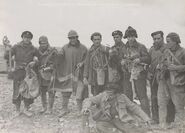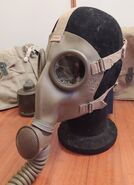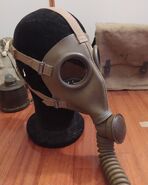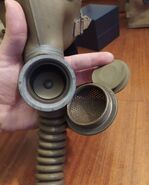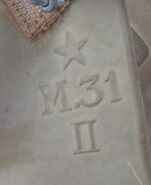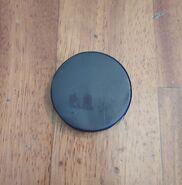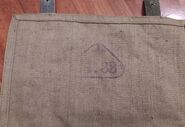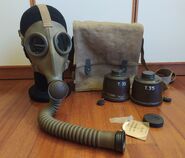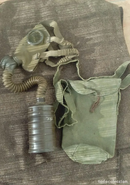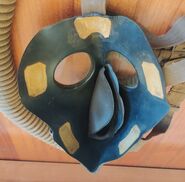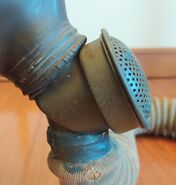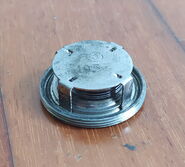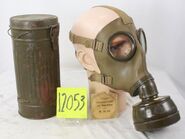Important note on the nomenclature: since the M.31 and M.33 facepieces are identical, they may be referred to as M.31-33, as the two masks were used interchangeably both doctrinally and practically.
The M.31 and the M.33 were the standard military gas masks of the REI (Regio Esercito Italiano, royal Italian army) from 1931 until 1949. A heavily modified variant was produced in Spain modifying Italian-made facepieces after the Spanish Civil War.
History[]
Development[]
During the late '20s, the Italian Army was seeking renovation in its chemical protection equipment. Since the end of the war, in fact, the Army was still using Small Box Respirators, which were considered outdated by every standard after the second half of the '20s. Because of that push, the army adopted the Penna Respirator in 1928. Although superior to the SBR, the design had some issues which brought the army to seek a new respirator, a search that ended in 1931 with the adoption of the M.31.
Improvements[]
This new design had the following improvements:
- Stiffer rubber and a different shape of the faceblank, especially around the connection with the metal assembly at the front, reduced drastically the instability of the latter, avoiding it from restricting airflow.
- The filter was completely overhauled, as the SBR-like shape was dropped in favour of a round one. The content was changed, making breathing easier, and the plug was now attached with a string, preventing it from being lost as easily.
- The 6-straps system was changed to a 5-straps one, as the latter had all of the elastic straps replaceable.
- The metal assembly was changed in such a way to allow easier maintenance of the inlet and exhale valves, the latter of which also saw a change in design, as the aluminium base was made of rubber instead, and because of that, there was no need for a gasket in between it and the assembly. Both valves were interchangeable between the two designs.
- The eyepieces were now crimped and could be replaced with little to no equipment
Adoption and service life[]
The M.31, and later the M.33, were mainly meant for use with the Army since it was too expensive to issue them to other corps that didn't require such a large filter (this niche was filled by territorial masks, like the T.32 and later the T.35). The mask is often seen in parades paired with a chemical suit, usually a 1930 model.
Spanish civil war use[]
During the Spanish Civil War, a great number of Italian masks were imported into Spain (318.908), most, if not all of these, were T.35s, which were adopted under the designation of "Modelo L". A lot of the Italian masks that enterd the coutry did so by being brought by the Italian voluntary corp, who mostly issued M.31-33s and Penna Respirators.
Author's note: it's unclear whether the M.31-33s and Pennas that entered the country came all from the volunteering soldiers or partially from the 318.908 gas masks imported to be used by the Nationalists.
These masks were occasionally captured by the Republicans (especially during the battle of Guadalajara in March 1937), who sometimes reissued them. Some Republican copies were developed, but there isn't much information about them.
Some M.31-33s also have been found with czech hoses with 42mm threads at the end, it's very likely that this modification was done during the War by the republicans, but there's no confirmation to that at the moment.
Second World War[]
During the War, the M.31-33 was brought on all theatre of war, alongside the T.35. It was never used during an actual chemical attack. Some soldiers discarded the mask and kept the bag, which would have been used as a knapsack. The mask could be also seen in war-time propaganda. Overall, it saw no development like the T.35 did.
Italian post-war use[]
After the end of the War, the M.31-33 didn't remain in service for much, and in 1949 it was officially ruled out in favour of the T.35, a simpler and lighter design that didn't require as much maintenance.
Spanish post-war use[]
After the end of the Spanish Civil War, the government set out to gather all of the various gas equipment issued by both sides, in an effort to re-issue said equipment in a standardized way. A lot of M.31-33 kits went through a recovery process and they started being issued designated as "L.M.33". The mask were often subject to changes, some times simple repairs and other times completely transformative (it's the case forL.M.33-A kits). They would get replaced by the M2-73 in the '70s, along with all the other masks used at the time.
Italian variants[]
Mask overview[]
The M.31 and M.33 facepieces are completely identical, save for the markings.
The mask is composed of the following parts:
The faceblank, made of moulded rubber, has the following parts attached to it:
- the housing for the exhale and intake valves
- the internal half-mask
- the hose
- the eyepieces
- the straps
At the bottom-front of the mask, there is a milled metal assembly with a mount for an intake valve, one for the exhale valve and its threaded lid, and two holes to connect said piece to the faceblank and the hose. The intake valve is a simple rubber disc placed over the hole where the hose is attached. The exhale valve is made of rubber, and it can be easily inspected and possibly replaced by unscrewing the lid of its housing.
Attached to the same end of the metal assembly as the faceblank there is an internal half-mask, made of black rubber. Its role is to reduce the dead space in the mask to a bare minimum by almost completely preventing airflow outside the mouth and nose area.
To the outmost end of the metal assembly, the rubber hose is attached. It's corrugated and connects the mask to the filter.
The eyepieces are made of "Triplex" glass, which itself is composed of two glass layers and a thin sheet of cellulose. This kind of glass prevents poisoned air to get into the mask even after being hit, as only the outside layer of glass would be shattered and the other two layers would maintain the seal. The glasses are affixed to the mask through aluminium frames.
The elastic harness has the goal to keep the mask tightly onto the face. It is composed of 5 adjustable straps (a top one, two elastic temple ones and two elastic cheek ones) attached to the facepiece, and they gather into a nape pad.
The anti-fogging disks are kept tightly onto the lenses by metal inserts and serve the purpose of maintaining good visibility.
The mask was marked on the inside of the facepiece with a register number, on the internal half-mask with the size and producer's logo, on the external right side with the kit's register number, on the hose with the year of production and the producer's logo, on the exhale valve with the producer's logo and on the external left side of the facepiece with the size, the producer's logo, the name of the mask and a series of dots that indicated the year of production, following the logic of mask name's year (either 1931 or 1933 in this case) + the number of dots (which could also not be there, meaning the mask was made in that exact year).
Filter[]
The filter was the only main difference between the M.31 and M.33 masks and the only reason why M.33 masks, even though identical to M.31s, had their designation changed.
M.31 and M.33 filters differed in content, but not in shape, and therefore both fit the following description:
The body is a cylinder made of aluminium painted dark brown. The diameter is 11 cm, the height is 21 cm and the weight is around 1 kg. On the upper side, there's a collar that is connected to the hose. On the bottom, there's a hole that lets the poisoned air in and, while the mask is not in use, it can be closed using a rubber plug attached through a string to the filter. This plug system was an upgrade over the Penna filter as the plug couldn't be lost as easily, so much so that it will be used in some form or another until the adoption of the M90. Inside the filter, there were riddled metal sheets that divided the filtrating layers, with the down most one having a spring that pushed the metal sheet upwards to create a small air chamber and making breathing easier. The filter was marked on the side and on the bottom with 4 letters, the first letter indicating the year of manufacture ("A" is for 1931, "B" is for 1932 and so on), and the other 3 indicating the filtrating layers in order from the top to the bottom of the filter. The filter also had a few lines of instructions at the top with the producer's logo and an additional date marking at the bottom (the latter with some exceptions, for unknown reasons). Unissued filters were plugged at the bottom with waxed canvas and at the top with a cork, and they were protected with some cardboard around the main body.
M.31-33 filters markings' key[]
Note that this key does not refer to the first letter of the marking, that indicates the year of production.
- c = massa antifumo, smokeproof mass
- z = granuli, granules
- a = carbone attivo di torba, peat activated charcoal
- g = carbone attivo G.1000, G.1000 activated charcoal
M.31[]
M.31 filters are marked with either an "A", a "B" (or in very rare cases a "C") as their starting letter and then "c", "a" and "z". Due to the adoption of the M.33 filter, M.31 filters ceased being produced in 1932. Some filters can be marked as "M33" followed by a date; this means the filter was re-issued. M.31 filters were in fact not much worse in comparison to M.33 filters, and they kept being used alongside them until they couldn't be used anymore. The autonomy was similar to M.33 filters, possibly just a little bit shorter, but currently, there is no data available on this topic. The waxed canvas plug is circular.
Transitional M.31-33[]
In early 1933 some M.31 filters were produced with the "g" layer instead of the "a" layer as in previous instances. This filter saw very limited production and its full designation is always: "C.c.g.z.". The waxed canvas plug is circular.
M.33[]
M.33 filters were marked with a "C" or a letter after this one as the starting letter and then "z", "g" and "c". These filters had an extra air chamber inside the filter between the "c" and the "g" layer to further ease breathing. The autonomy of M.33 filters was at least 15 hours with all gasses even with a high concentration with the exception of arsines, which reduced the autonomy to a degree, and CO, which was not filtered at all. The waxed canvas plug is square.
Kit[]
Standard variant[]
Regular M.31 and M.33 masks were issued with a kit similar to the one previously seen with the Penna respirator, but there were major changes and improvements. The kit comprises of:
- M.31 carrier
- M.31 or M.33 filter
- An envelope with spare anti-fogging lenses
- A small box with a spare exhale valve
The carrier was a square bag divided into two parts, one for storing the mask while not in use and the other to keep the filter. In the latter, an angled piece of metal kept the intake hole of the filter elevated from the bottom of the carrier to allow free airflow. On the front of the carrier, there are two small pockets that are used to store the extra anti-fogging lenses and the spare exhale valve. The carrier is closed with two tabs at the front and automatic button between the two cloth parts over the inside. The strap system comprises a quickly-reduceable shoulder strap and a twine string. When the kit was carried, the soldier would keep the shoulder strap extended and adjusted based on their height, while in case of gas alert the shoulder strap would be shortened using a special tab, the carrier would be placed on the chest and the twine string, through two metal loops in the carrier, would be used to fasten the carrier tightly onto the wearer's chest to avoid it from bouncing. The bag's quality varied during the years, with later models having less fine knitting and a tab like the ones on the front on the part where the automatic button would be.
The filter was kept on the left part of the bag. M.31 kits were issued with both M.31 and M.33 filters, while M.33 kits were issued only with M.33 filters.
The M.31 and M.33 were usually issued with two pairs of anti-fogging lenses, one pair was already installed on the mask while the other was still in its envelope and inside one of the two front pockets. Unissued kits don't have anti-fogging lenses already installed. The envelope was marked in various ways depending on the production date, with the difference being the name of the mask written on it, which were "M.31", "M.31-33", "M.31-33 e T.35", but the content did not change the slightest.
The spare exhale valve was stored in a small box kept in one of the two front pockets. The design of the box varies depending on the producer and the model, with M.31 ones being slightly smaller, but the content was the same.
Threaded variant[]
The replacement of M.31 and M.33 filters was very laborious, as tape and wire were needed for each substitution, making this process unpractical on the field. This operation was much easier and quicker with threaded intakes, which, in case of a chemical attack, would be determining.
To solve this problem, some M.31 and M.33 masks were fitted with a threaded intake at the end of the hose which would allow T.35 filters and other threaded filters to be attached (CO filter). This way the "maschera antigas M.33 modificata" (modified M.33 gas mask) was born.
The kit was almost the same as the regular variant, differing only in the filters issued, which were 2 T.35 ones for each kit. This was done because T.35 filters lasted only half as much as M.33 ones, and therefore a spare filter was issued to maintain the long autonomy of the regular M.31-33 kit.
Spanish variants[]
This section refers to all M.31-33 masks that were issued in Spain and then subsequently modified for a variety of reasons: a lot of masks had their kit changed during the War because of supplying problems and general lack of proper spare parts. It's common to see improper bags, like T.35s', civilian knapsacks or other military gas mask carriers. After the War, the kits issued with the army would hold a stricted standard for what was allowed as a modifications but there is still a lot of variety.
Author's note: Some of the kits that are found may be collector's mixups, so it's important to take that into consideration when identifying an example.
Republican kits[]
The Republicans captured and re-issued numerous M.31-33s during the War, especially after the battle of Guadalajara in 1937. The kits that were re-issued were often identical to the standard kits, but occasionally repairs to the masks were made, which most frequently consisted in replacing the filter, hose, valves, or inlet-outlet assembly. Sometimes repairs were done with non firm-consistent parts (for example, an IAC facepiece with a Pirelli hose); in the case that the filter, hose or inlet-outlet assembly were to be replaced, they would be taped back using tape, wire, red string and then tape again, covered in blue paint afterwards. Some masks can present
It's unclear whether the white tape used over the seams between the faceblank and the straps was done during the War or not.
Republican kits are also frequently spotted with bags different from the standard one, usually either a T.35 bag or a random knapsack, or another unrelated gas mask carrier (one example with a Penna bag has been spotted).
Republican converted M.31-33[]
Some of the M.31-33 masks captured by the Republicans were converted to use 42mm filters, which were the most common among the Republican army. In this conversion, the hose was fully removed and replaced by a longer and stockinette-covered Czech one, provided with a 42mm thread.
The kit usually has signs of recovery, those being the label on the filter and extra tape covering the seams between the straps and the faceblank (the latter might have been added during the War), suggesting this kit may have been re-issued after the War as an L.M.33 kit.
L.M.33[]
The name "L.M.33" was the post-War designation assigned to those M.31 and M.33 kits that were used by the Spanish Army. Some elements of the kits were variable, with the most constant factor being the faceblank itself (with some rare exceptions).
The facepeice can sometimes present extra tape covering the seams between the straps and the faceblank, which is possibly a wartime repair. The hose was preferrably replaced always with one from the same company in order to keep it the same colour as the rest of the mask, but there's no saying whether this was always the case, as it may have gotten replaced with one from a different company or a Penna one. The connections between mask and inlet-outlet assembly, inlet-outlet assembly and hose, and hose and filter can be of three different types: either the original tape and wire, the Republican wiring technique (tape, wire, red string and then tape again, covered in blue paint afterwards), or the post-War wiring technique (1 and quarter turns of rubberized tape, two separate fastened wires, and 1 and quarter turns of rubberized tape).
The exhale valve can be replaced with any exhale valve from either another M.31-33 or an L.T.35. The inlet valve (35mm wide) could be replaced with any M.31-33 inlet valve, regardless of the producer, but also with an inlet valve from any Victoria, Dagsa or N.24 (all three 33mm wide), L.T.35 (35mm wide), Fatra (36mm wide), or in rare cases CMP masks (with the latter being not recommended in manuals due to the extra breathing resistance caused by the excessive diametre, 37mm).
The harness can sometimes present straps with material different from the original fabric: these types of repairs were made when the non-elastic part of a strap was thorn, otherwise the entire harness was replaced.
The kit consisted of the following:
- M.31-33 facepiece and hose, sometimes with the mild modifications mentioned (very rarely a specially modified Penna facepiece, possibly also a Republican converted M.31-33)
- M.31 or M.33 filter, either Pirelli or IAC made (possibly also a Czech filter, only with a Republican converted M.31-33)
- Carrier, most of the times an M.31-33 bag, but possibly a Penna bag or a CMP bag in rare cases
- At least a set of anti-fogging lenses, sometimes present only when issued.
L.M.33-A[]
During the early '60s, a great number of L.M.33 kits were modified in such a way that would allow the use of directly-attached modern 40mm filters. The reasoning behind this drastic modification was bringing the L.M.33 kit to fit into the doctrine used for most of the other masks used at the time by the Army, as a hosed mask requires more care in storage and transportation and takes up more space (20 masks for crate with L.M.33 kits, 25 masks for crate with L.M.33-A kits).
This modification consisted of the following:
- Removal of the nosecup and inlet-outlet assembly
- Addition of a N.24/Dagsa-style inlet-outlet assembly, fixed with a clamp (same used with refurbished T.35s)
- Addition of the Spanish green paint, done without disassembling the mask, which often resulted in paint stains on the lenses.
- Only in some cases, there is a production number printed over the Italian one; not all masks have it
The kit comprised of the following:
- The mask itself
- A repainted tube carrier from either an N.24, a Dagsa or a Victoria
- The filter, which can be any 40mm filter used at the time in Spain
- At least a set of anti-fogging lenses, sometimes present only when issued.
The inlet valve used in the newly attached housing could be either one from any Victoria, Dagsa or N.24 (all three 33mm wide) or otherwise from a normal L.M.33 or L.T.35 (both 35mm wide).
L.M.A. with IAC M.31 facepiece[]
L.M.A. with Pirelli M.31 facepiece[]
Spanish M.31-33 copies[]
main article: Spanish M.31-33 copies
After the battle of Guadalajara in March 1937, the Republican Army captured hundreds of Italian gas masks, which would be issued against the nationalists during the rest of the war. Some of the captured T.35s and M.31-33s were also sent to Bilbao and Catalonia to develop a copy: these copies were produced in Bilbao, Villanova, La Geltrú and in Catalonia (unknown numbers).
Civilian variant[]
main article: IAC 310
The IAC 310 was a slightly altered variant of the M.31, sporting a slightly different exhale valve assembly and a dedicated filter (similar in shape to the military issue one).
Rebreathers[]
The M.31-33 facepieces were commonly produced and used with rebreathers of the era. The main companies producing and using these facepieces were Spasciani, Pirelli and SAB. The facepieces used in this fashion did not sport the usual assembly at the front like the Army variant, instead, a metal cylinder would connect the mask directly to the hose that was attached to the rebreather unit at the other end.
Rebreathers with an M.31-33 facepiece[]
- C.C.M. 33
- MOD.35.S.
- S.C.M. 37




